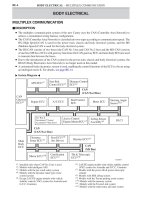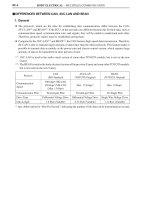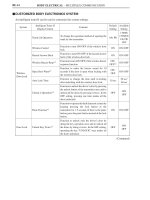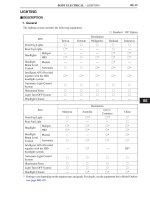Ô tô Camry 3.5Q - Phần 2- C25
Bạn đang xem bản rút gọn của tài liệu. Xem và tải ngay bản đầy đủ của tài liệu tại đây (162.19 KB, 4 trang )
MO
NEW MODEL OUTLINE
MO-25
Audio System
D The large and varied original LCD panels and large switched have been provided for each audio head unit,
improving visibility and ease of use.
D By implementing new DSP (Digital Signal Processor) technology with psychoacoustic theory, less
distorted, clear, powerful sound quality has been achieved.
— REFERENCE —
Psychoacoustic Theory:
Psychoacoustic theory is technology that exploits human perceptions (sensory illusions). Through the
implementation of this technology, without changing the speaker sizes or locations, listeners can sense
deeper bass sound (1) and feel as if the speakers were located at eye level, despite them being located in low
positions like door speakers (2).
(1) Bass Sound Reproduction Principle: Since olden times, when pipe organs are built in churches, due to
the difficulty of housing long resonating pipes for very low tones, a technique has been used which
reproduces low tones through the utilization of two short pipes.
When two pipes, of which the frequencies are 100 Hz and 150 Hz, are sounded simultaneously to
reproduce a note at 50 Hz, human brains discern four different notes at 100 Hz, 150 Hz, 250 Hz (100 Hz
+ 150 Hz) and 50 Hz (150 Hz – 100 Hz). Among these, human brains perceive the frequency difference
of 50 Hz most strongly.
By electrically generating differential components from fundamental notes for very low tones and
emitting them through speakers, the human brains sense the deep bass sound despite it being not
emanated from the speakers.
(2) Virtual Sound Source Layout: When the theory of HRTFs (Head Related Transfer Functions) is employed
in the vertical direction, human brains perceive the source of sounds emitted from the speakers in the
lower positions as if it was at windshield level.
HRTFs are acoustic transfer functions from the sound source to the ears.
It is said that humans detect the location of sound sources through time differences and physical reflective
interference; the horizontal direction is recognized through the time difference between the sound
reception of the left and right ears, and the vertical direction is discerned through the reflective
interference caused by the head and earlobes.
Sound sources can be virtually reproduced by incorporating the HRTFs into amplifiers and emitting the
sound through speakers.
NEW MODEL OUTLINE
025MO29Y
LHD Model
026MO13Y
LHD Model
02KMO44Y
RHD Model
02KMO45Y
RHD Model
*
1
: Compatible with the compressed sound and music files complying
with MP3 (MPEG Audio Layer-3) standard and WMA (Windows Media Audio)
*
2
: Digital Signal Processor
*
3
: Automatic Sound Levelizer
MO-26
Audio Head Unit
The three types of audio head unit are available.
Design
Specifications
D AM/FM Tuner
D CD (MP3, WMA Compatible*
1
)
D DSP*
2
/ASL*
3
D 6-Speaker System
D Maker: Fujitu Ten
D AM/FM Tuner
D In-Dash 6-CD Changer
D CD (MP3, WMA Compatible*
1
)
D DSP*
2
/ASL*
3
D 6-Speaker System
D Maker: Fujitu Ten
D AM/FM Tuner
D CD (MP3, WMA Compatible*
1
)
D DSP*
2
/ASL*
3
D 6-Speaker System (Except Australian Models)
D 4-Speaker System (Australian Models)
D Maker: Fujitu Ten
D AM/FM Tuner
D In-Dash 6-CD Changer
D CD (MP3, WMA Compatible*
1
)
D DSP*
2
/ASL*
3
D 6-Speaker System
D Maker: Fujitu Ten
(Continued)
MO
NEW MODEL OUTLINE
02KMO46Y
271MO61
02KMO52Y
LHD Model
02KMO51Y
Australian Model
DR019MO34
is the trademark of SRS Labs, Inc.
MO-27
Design
Specification
D 6.5-inch Display
D AM/FM Tuner
D Cassette Player
D 6-Speaker System
D Maker: Fujitsu Ten
D AM/FM Tuner
D Cassette Player
D 4-Speaker System
D Maker: Fujitsu Ten
D 7.0-inch Display
D AM/FM Tuner
D Bluetooth
Hands-free System
D DSP*
2
/ASL*
3
D 6-Speaker System
D Maker:
– DENSO (Except models for Australia and
G.C.C. Countries)
– Fujitsu Ten (Models for Australia and G.C.C.
Countries)
D 7.0-inch Display
D AM/FM Tuner
D In-Dash 4-CD Changer
(MP3, WMA Compatible*
1
)
D Bluetooth
Hands-free System
D DSP*
2
/ASL*
3
D 6-Speaker System
D Maker:
– DENSO (Except models for Australia and
G.C.C. Countries)
– Fujitsu Ten (Models for Australia and G.C.C.
Countries)
*
1
: Compatible with the compressed sound and music files complying
with MP3 (MPEG Audio Layer-3) standard and WMA (Windows Media Audio)
*
2
: Digital Signal Processor
*
3
: Automatic Sound Levelizer
NEW MODEL OUTLINE
02KMO39Y
(1)*
(1)*
(2)
(2)
(3)
(3)
MO-28
Speaker
"
Speaker Location
A
"
Speaker Specifications
A
Location Speaker Type Caliber Impedance
Input
Rated
(1)* Front Tweeter x 2 65 mm (2.6 in.) 4 Ω 17.5 W
(2) Front Midrange x 2
150 x 225 mm
(6.0 x 9.0 in.)
4 Ω 20 W
(3) Rear Full range x 2
150 x 225 mm
(6.0 x 9.0 in.)
4 Ω 20 W
*: Except for Australian and G.C.C. Countries models with the 4 speaker system









